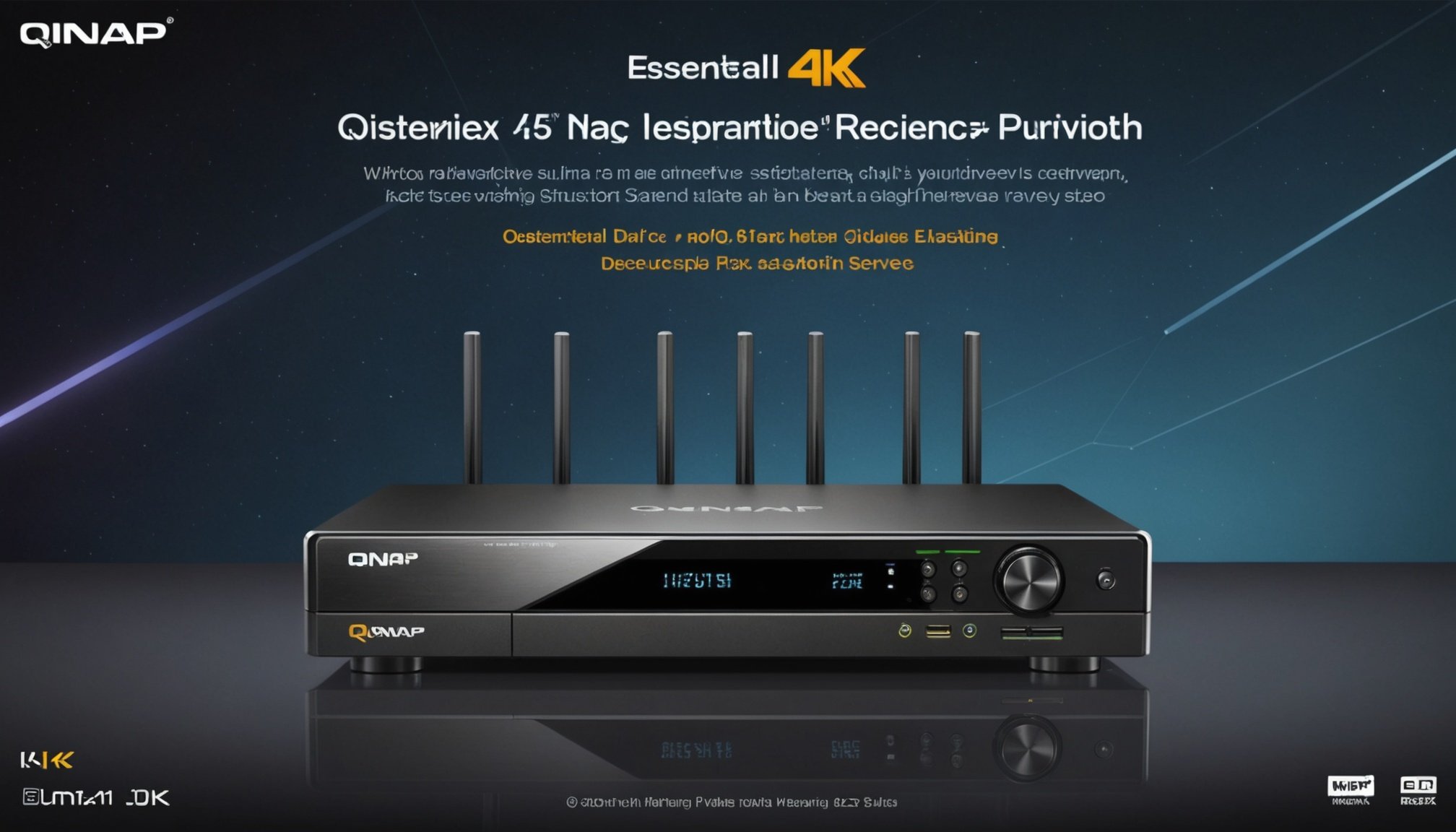Understanding QNAP TS-451+ NAS and Plex Media Server
The QNAP TS-451+ is renowned for its robust media storage capabilities, making it an ideal choice for home and small business use. Equipped with a quad-core processor and upgradable up to 8GB of RAM, it ensures efficient handling of data-intensive tasks. Notably, the QNAP TS-451+ supports various RAID configurations, providing users with options for enhanced data protection and performance.
When paired with Plex Media Server, your media storage becomes a powerhouse for 4K streaming. Plex Media Server excels in organising and streaming content, allowing users to easily access movies, music, and photos from any connected device. Its user-friendly interface simplifies media management, supporting a wide array of formats.
Additional reading : Maximize your synology ds918+: effective storage and backup techniques for a streamlined home office
Combining the QNAP TS-451+ with Plex Media Server significantly optimises media performance. Together, they deliver seamless 4K streaming, reducing buffering and improving quality. The integrated system allows for transcoding, adapting media for compatibility across different devices. Furthermore, this combination enhances streaming on-the-go by enabling remote access to media.
To summarise, leveraging the features of both the QNAP TS-451+ NAS and Plex Media Server transforms how you store and consume media. This pairing is a compelling choice for those who prioritise streaming versatility and efficiency.
Also to see : Ultimate guide to silencing your home recording studio using a tailored pc configuration
Configuration Requirements for 4K Streaming
Configuring a system for 4K streaming can seem daunting, but understanding the basic requirements will pave the way for a smooth experience.
Essential Hardware Requirements
For seamless 4K streaming, your hardware configuration plays a crucial role. Ensure that your streaming device supports 4K video playback; this can be a smart TV, a 4K-compatible media player, or a computer with a 4K-capable graphics card. Also, your storage solution, such as a QNAP NAS device, should have sufficient speed and capacity to handle large 4K files without bottlenecks.
Recommended Network Settings
Network settings should not be overlooked. A stable and high-speed internet connection—is crucial for achieving the best performance in 4K streaming. Ideally, your setup should support a minimum of 25 Mbps download speed. For QNAP NAS and Plex, using a wired Ethernet connection can reduce buffering compared to Wi-Fi.
Configuration Steps for QNAP and Plex
To link a QNAP NAS and Plex Media Server for 4K streaming, ensure both devices are on the same network. Install the Plex application on your NAS device, and follow the setup instructions to ensure the hardware and network settings are optimised for streaming. By prioritising these steps, you enhance performance, ensuring an enjoyable streaming experience.
Optimizing Plex Settings for 4K Playback
Enhancing your Plex settings plays a pivotal role in ensuring seamless 4K playback. Adjustments in video quality, transcoding, and hardware acceleration can revolutionize your streaming experience.
Video Quality Settings
When it comes to 4K content, choosing the right video quality settings is paramount. Begin by ensuring your server and streaming devices support 4K resolutions. Navigate to Plex settings and select the highest available quality within your bandwidth capabilities. This ensures the sharpest image without sacrificing stability.
Transcoding Options
Transcoding is a crucial factor in buffering reduction and playback smoothness. Dive into the transcoding settings on your Plex server, aiming to utilise maximum CPU capacity without overloading it. Set transcoder quality to automatic or lower it if excessive buffering persists. Format compatibility is also essential; use direct play options wherever feasible to bypass unnecessary transcoding.
Enable Hardware Acceleration
In addition to optimizing settings, enabling hardware acceleration can drastically improve performance. This feature offloads tasks from your CPU, utilising GPU capabilities for more efficient high-resolution streaming. To activate, check the hardware acceleration box within Plex settings, compatible with supported devices and drivers. This step often results in smoother playback, reduced CPU load, and enhanced energy efficiency.
Common Setup Issues and Troubleshooting
Setting up your device can be a breeze, but sometimes troubleshooting is necessary to tackle those annoying setup problems. If you encounter connectivity issues, it’s essential to check your network settings first. Make sure your device is connected to the Wi-Fi by verifying the network details. If this doesn’t resolve the issue, consider restarting your router and device, as this simple step can sometimes rectify the problem.
Transcoding performance problems can be a hurdle, particularly if your system’s hardware is not up to the task. An underpowered processor often causes delays or buffering during transcoding. Enhancing your device’s performance by adjusting the settings to optimise for your current hardware can alleviate these problems. It’s also prudent to close any background applications consuming your device’s resources, as this imbalance is often overlooked.
Playback quality concerns can significantly diminish the user experience. If you’re facing playback quality issues, start by examining the media file’s compatibility with your device. Often, formats that are not natively supported may necessitate conversion. Additionally, ensuring that your video settings are configured correctly, such as adjusting the resolution and bitrate, can improve viewing quality. Addressing these specific areas can make your setup smoother, allowing for an enhanced, uninterrupted experience.
Advanced Tips for Enhancing 4K Streaming
Exploring ways to improve your 4K streaming involves understanding both media organization and metadata management. These elements are crucial for a seamless viewing experience.
Organizing Media for Efficiency
A well-organized media library significantly boosts streaming efficiency. Start by creating distinct folders for different content types such as movies, series, and documentaries. Use a naming convention that includes the title, release year, and resolution (e.g., “MovieTitle2023_4K”). This systematic approach aids in quick media retrieval, especially on platforms like QNAP. Regularly reviewing and tidying up your library ensures that clutter doesn’t slow down your system, making for a smoother streaming experience.
Utilizing Metadata for Enhanced Experience
Metadata plays a pivotal role in enriching your streaming journey. It provides essential information about each media file, including cast, genre, and plot summaries, transforming a basic collection into a detailed media database. Implementing metadata management involves regularly updating this information to ensure accuracy. This meticulous attention to metadata not only makes navigation effortless but also personalizes viewing by suggesting content based on user preferences. Utilizing community tools and applications can simplify this task, automating much of the metadata harvesting and updating process for continuous enhancement.
Community Resources and Further Learning
Navigating the world of QNAP and Plex can become a complex task. Community forums offer a wealth of knowledge, providing user-driven solutions, advice and sharing best practices crucial for both novice and experienced users.
Notable Online Communities
QNAP and Plex boast vibrant communities. The QNAP forums are invaluable for troubleshooting and sharing insights related to network-attached storage (NAS). Similarly, Plex’s forums are bustling with discussions about media server setups, troubleshooting, and new features. Engaging in these forums allows users to gain valuable tips, stay informed on updates, and connect with fellow enthusiasts.
Recommended Forums and Resource Sites
Subreddits like r/qnap and r/plex provide platforms where users discuss issues, share media server setups, and explore software updates. Websites such as the Plex Media Server subreddit offer insights into best practices, making it easier for users to adopt and optimise their home media environment.
Importance of Staying Updated
Staying updated with software updates and best practices is pivotal. These updates often include important security patches, new feature releases, and improvements in stability. Engaging with online resources ensures you remain at the forefront of developments and can utilise these platforms effectively while enhancing your media experience.






